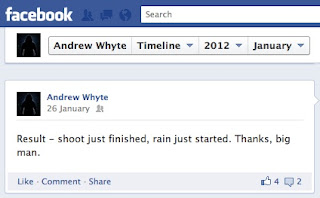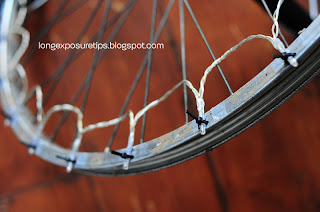 |
| Cover of the current issue |
Last week saw the publication of N-Photo issue #5 featuring a behind the scenes look at an intensive night shoot covering five individual styles in one extended session. Here's the story of the story and how it all came together - you've never been so far behind the scenes!
The shoot had been in the planning since the week the magazine was first announced back in September or October. N-Photo is a brand-specific publication, following on from the success of its sister title for Canon users. Naturally, as a Nikon devotee I wanted to be a part of it so I got in touch. After considering my portfolio, I heard back from the editorial team offering me the chance to induct an apprentice into the dark art of night photography. I love to share my knowledge and experience so it seemed a great way of getting involved.
With a tip of the cap towards nostalgia we arranged to meet on the day of the shoot in the Krispy Kreme donut store. It's where so many great evenings with the Portsmouth at Night flickr group started from so seemed fitting to commence our own shoot there too.
Eddie (the apprentice) seemed enthusiastic to learn and had a healthy level of general photographic experience, not to mention a shiny D7000 for us to spend the night shooting with. Chris (the editor) frantically scribbled notes about Eddie's and my backgrounds; and Andy (the mag photographer) and I spent a few minutes geeking out about gear, why we preferred being behind the camera, and the rise of the weekend warrior. With the formalities done and dusted we headed off to the first of the night's locations to shoot some traffic trails.
 |
| Even caught the oncoming blue lights of a police car in one of our early shots (© Eddie Bull) |
Arriving pre-rush hour gave us chance to set up with time to spare and a bit of light to see what we were doing. I don't know exactly what gave it away but it was during this first set of shots it dawned just how long a night we were in for. Our Apprentice shots were taking up to 30sec per frame, and for each composition we needed several frames to choose the strongest aesthetically. We needed a choice of compositions, and to top it off Andy, the mag's own photographer, was diligently recording every step of the way which required lots of unnatural pauses and enforced smiles :) A full three hours after meeting, we'd travelled less than 5 miles and bagged one shot. Let's move on, shall we?
The next stop was to lightpaint the car- a Galaxy people carrier kindly loaned to us by Ford. The concept had been to combine the car shot with some star trails (Galaxy, geddit?) and I'd provided Chris (the editor) with an itinerary to help keep us on track. What I hadn't been able to account for was the weather and sadly this night was anything but clear. Scrapping the startrails meant an impromptu location change and whilst I'm a big advocate of fresh locations, this wasn't the time to be discovering the unexpected. Instead we headed to a site I've used once before: just two miles away from the motorway bridge on which we'd started stands an impressive vista over Portsmouth. When it's clear, you can make out so much of the island and beyond but it wasn't to be… with light-polluted cloud hanging over us and occasional spots of rain keeping us alert to the conditions, we livened up with a cup of tea from the Thermos before stepping out into the hilltop gusts.
I have an arsenal of lightpainting gear, ranging from my home-made 3500 lumen ShadowKiller down to the light on the back of my mobile phone - used for high-ISO work. For the mag, though, we chose to use something accessible by most of the readers that didn't require too much faffing around with settings.
Over the next couple of hours we lit the car, posed for the camera, and did it all to coincide with gaps in the traffic - sometimes to dodge oncoming cars, other times to capture outgoing taillights. It's one such moment that's used as a double-page spread to open the feature on page 10 of the mag.
 |
| Four lighting frames and a colour shift - all done in camera (© Eddie Bull) |
 |
| Andy's portrait orientation lends itself to this full-page preview format. |
Out of sight of both cameras was an SB-800 speedlight that was being triggered by CLS - Creative Lighting System, another awesome Nikon feature that gives you full control of your speedlight setup from the camera's menu - using this system is also covered in the feature. Andy synced his settings to those on the D7000 and we drove through the city - can't be sure but I think Chris might have had a sneaky power nap back in the car park while this was going on. Each time Andy opened his shutter, Eddie waited a second then fired the D7000 which triggered the speedlight - that way both images were able to take advantage of a single flash burst. The main qualities I looked for in the driving shot were symmetrical composition and balanced, well-exposed light trails. Mostly it's down to timing the opening of your shutter so in just a few minutes we were ready to move on to shot number four. Interestingly, Chris exercised his editorial discretion to publish one of the more frenetic shots we captured.
At nearly midnight we headed out of town, in search of the kind of murky darkness you only get in rural areas. I dragged a whole bunch of lightpainting tools out of the car - to be fair, that's probably the hardest I worked all night - and with rain threatening, we set up in the relative shelter of a disused railway underpass. Andy continued to record each step, working in unparalleled darkness and having to take into account not only the lightpainting but the need to show Eddie's camera. It was a tough gig for sure.
 |
| Talking of test shots here's a frame to check the flash exposure before setting off for the driving shot. |
With the end in sight we moved less than 50 metres but could've been worlds away. The Victorian brick surrounds of the railway were literally behind us, replaced through the viewfinder with extensive woodland - the perfect setting for a freaky silhouette.
Now, when I work solo I only use my torch for photographic purposes, once everything's set up. Maybe I eat more carrots than most but I find it more hindrance than helpful to have to keep adjusting to torchlight flashing on and off. I want to see like my camera will, picking up every pixel of ambient light and its tone. Without telling tales, let's just say that in the company of others and their torches, it took longer than usual to compose the final shot...
There's not a lot more to say about the last few minutes of the N-Photo encounter. The shot was again nailed on the second take, 100 seconds of flapping around with EL wire whilst the background light pollution slowly burnt into the scene. The key to the crisp silhouette was not so much that the subject was asleep (although he may well have been by this time) nor the threat of punitive measures if we had to shoot it again; instead, I worked from head to toe doing my best to communicate each stage of the process so he knew when it was ok to relax.
 It was nigh-on 3am when we headed our separate ways. Within minutes the clouds finally succumbed to their own weight and unleashed torrents of rain but we'd achieved what we set out to do.
It was nigh-on 3am when we headed our separate ways. Within minutes the clouds finally succumbed to their own weight and unleashed torrents of rain but we'd achieved what we set out to do. The published feature will appeal to all photographers with an interest in low light techniques and light painting, but with the magazine's brand loyalty some of the killer tips are those aimed at Nikon users- namely custom settings, Image Overlay and using CLS to control speedlights.
I'm particularly impressed with how well the images printed - away from the luminance of a computer screen it's really easy for night images to look badly underexposed but the N-Photo team have clearly worked hard to reproduce the pictures honestly.
To Eddie, Chris and Andy, it was a genuine pleasure working with you all!
Next up on the blog - I'll be posting shortly an updated version of my driving shots tutorial.







